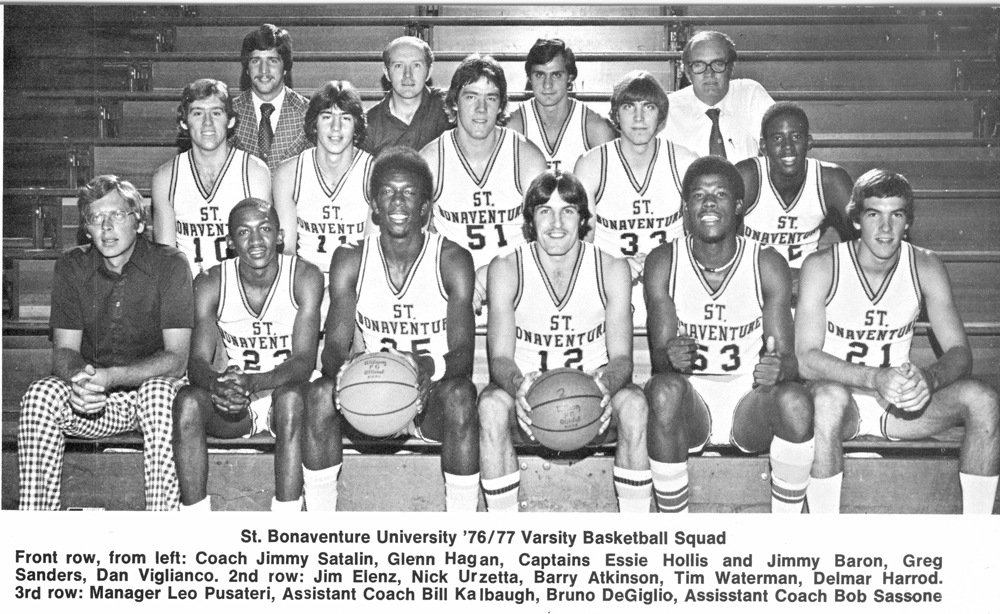
In Fall 1976, Jim Satalin knew his team was good. Just how good was the story.
The Bonnies went 14-10 in their 1975-1976 season. They lost their last regular season game at third-ranked Rutgers, 85-80, in a heartbreaking defeat. With a 24-0 record to that point, the Scarlet Knights hadn’t really been tested in their College Avenue Gymnasium. The Bonnies managed the game for nearly the entire contest before a controversial foul in the closing seconds sealed the Rutgers’ victory. With 30 seconds left, Jim Baron seemingly stole the ball from Rutgers guard Mike Dabney in open court where the Bonnies were poised to score and tie the game at 82.
An apparent late whistle against Baron on the steal affected the outcome. Even Eddie Jordan, a guard for Rutgers at the time, acknowledged as much on another website, “He (Baron) took two dribbles, then a whistle blew,” he said.
Satalin remembers the call 46 years later. “It was a tough call to have at that particular time of the game, and that saved them their undefeated season,” he said.
Nonetheless, the defeat to Rutgers may have shown something to four of the Bona starters: Essie Hollis, Greg Sanders, Glenn Hagan, and Jim Baron. “We were good that year,” Satalin recalled. “All of those guys were ready to take the next step, and that game showed them that they could do that.”
The team lost 6-7 forward/center Bob Rozyczko and his 17 points per game average to graduation, but the foursome of Hollis, Baron, Hagan, and Sanders brought a 55 points-per-game average into the ’76-77 season.
Then there was 6-8 Tim Waterman, a true center that even Satalin acknowledged was missing from the previous year. “Timmy was our only size to speak of,” Satalin said. “We kind of almost gave him that [center] position and hoped that he could handle it. He more than handled it for us. He was the kind of guy who did all the dirty work. He didn’t need the ball at all. He didn’t need to take any shots. He blocked out. He rebounded.”
“Timmy was a key factor on that team. It took so much pressure off the other guys,” he added.
The ’76-77 Bonnies jumped out to an 11-3 record by the end of January, losing only at Georgetown and DePaul and to Princeton at the Rochester War Memorial in the championship of the Kodak College Basketball Classic. The 55-point output by Bona against Pete Carril’s Tigers was a season low, yet was two points more than opponents’ average against Princeton. The Bonnies shot 36 percent from the floor, far lower than their 57 percent success rate per game to that point in the season.
Fast forward to February 12, 1977. The Bonnies had just come off consecutive road losses to two Top 20 teams. Providence (#15) upended St. Bonaventure, 82-75, before a Dick Vitale-coached Detroit squad (#19) defeated the Bonnies, 78-62, in the Motor City. (This brief stretch may be the only consecutive three-game run of facing top 20 teams in Bona history.)
At 14-4 on the season, the Bonnies were looking to rebound in facing Syracuse (#17) in the Reilly Center. They responded.
Hollis scored 37 points—27 in the first half alone—before a capacity crowd in what was Jim Boeheim’s first year as the Orangemen head coach. Hollis scored 27 of Bonnies’ first 50 points as they headed into halftime with a comfortable 52-33 lead. Syracuse started the game in an uncharacteristic man-to-man defense instead of a 2-3 zone, something that surprised Satalin according to an Olean Times Herald post-game story. Boeheim’s assessment in the same story echoed respect for the Bona offensive threat in saying, “We couldn’t play zone here, not with the shooters they have.”
The Bona backcourt of Baron and Hagan got into early foul trouble, but Satalin’s squad got 18 bench points from Dan Viglianco (8 points), Delmar Harrod (5 points), and Nick Urzetta (5 points). The Times Herald story related that Satalin “juggled his lineup like a master magician.”
The Bonnies reeled off another four straight victories to end the regular season at 20-5.
In a game with likely NCAA implications, Syracuse enacted revenge in the ECAC tournament game at the Manley Field House in Syracuse in early March. Hollis got into early foul trouble in the 85-72 loss. Syracuse got the subsequent NCAA bid (32 teams at the time) and lost in the second round to Charlotte, 81-59.
The loss—what became the last setback of the ’76-77 season— may have been historic for St. Bonaventure. A win may have vaulted the team into the 32-team NCAA tournament. Instead a 16-team NIT opportunity awaited.
